Discover 35 hidden attractions, cool sights, and unusual things to do in New York City (United States). Don't miss out on these must-see attractions: Statue of Liberty, Solomon R. Guggenheim Museum, and Metropolitan Museum of Art. Also, be sure to include Central Park in your itinerary.
Below, you can find the list of the most amazing places you should visit in New York City (New York).
Table of Contents
Statue of Liberty

American icon in New York Harbor. The Statue of Liberty is a colossal neoclassical sculpture on Liberty Island in New York Harbor in New York City, in the United States. The copper statue, a gift from the people of France to the people of the United States, was designed by French sculptor Frédéric Auguste Bartholdi and its metal framework was built by Gustave Eiffel. The statue was dedicated on October 28, 1886.
The statue is a figure of Libertas, a robed Roman liberty goddess. She holds a torch above her head with her right hand, and in her left hand carries a tabula ansata inscribed JULY IV MDCCLXXVI (July 4, 1776 in Roman numerals), the date of the U.S. Declaration of Independence. A broken shackle and chain lie at her feet as she walks forward, commemorating the recent national abolition of slavery. After its dedication, the statue became an icon of freedom and of the United States, seen as a symbol of welcome to immigrants arriving by sea.
Bartholdi was inspired by a French law professor and politician, Édouard René de Laboulaye, who is said to have commented in 1865 that any monument raised to U.S. independence would properly be a joint project of the French and U.S. peoples. The Franco-Prussian War delayed progress until 1875, when Laboulaye proposed that the French finance the statue and the U.S. provide the site and build the pedestal. Bartholdi completed the head and the torch-bearing arm before the statue was fully designed, and these pieces were exhibited for publicity at international expositions.
The torch-bearing arm was displayed at the Centennial Exposition in Philadelphia in 1876, and in Madison Square Park in Manhattan from 1876 to 1882. Fundraising proved difficult, especially for the Americans, and by 1885 work on the pedestal was threatened by lack of funds. Publisher Joseph Pulitzer, of the New York World, started a drive for donations to finish the project and attracted more than 120,000 contributors, most of whom gave less than a dollar (equivalent to $29 in 2020). The statue was built in France, shipped overseas in crates, and assembled on the completed pedestal on what was then called Bedloe's Island. The statue's completion was marked by New York's first ticker-tape parade and a dedication ceremony presided over by President Grover Cleveland.
The statue was administered by the United States Lighthouse Board until 1901 and then by the Department of War; since 1933 it has been maintained by the National Park Service as part of the Statue of Liberty National Monument, and is a major tourist attraction. Public access to the balcony around the torch has been barred since 1916.[1]
Address: Liberty Island, 10004 New York
Solomon R. Guggenheim Museum
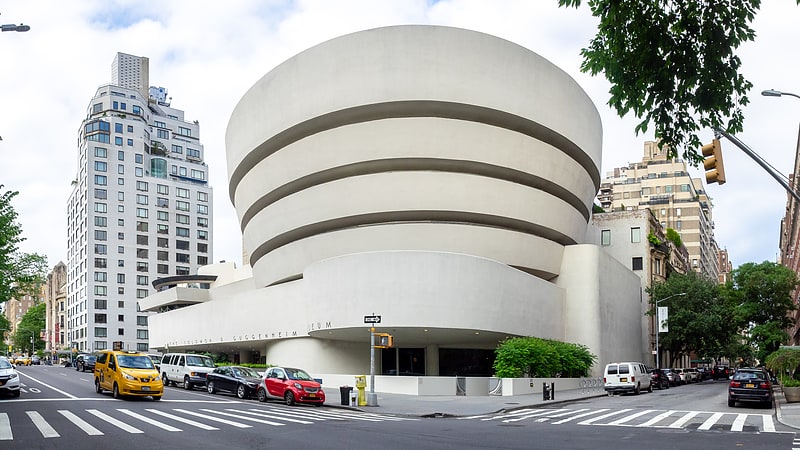
Modern art museum with a notable design. The Solomon R. Guggenheim Museum, often referred to as The Guggenheim, is an art museum at 1071 Fifth Avenue on the corner of East 89th Street on the Upper East Side of Manhattan in New York City. It is the permanent home of a continuously expanding collection of Impressionist, Post-Impressionist, early Modern, and contemporary art and also features special exhibitions throughout the year. The museum was established by the Solomon R. Guggenheim Foundation in 1939 as the Museum of Non-Objective Painting, under the guidance of its first director, Hilla von Rebay. It adopted its current name in 1952, three years after the death of its founder Solomon R. Guggenheim.
In 1959, the museum moved from rented space to its current building, a landmark work of 20th-century architecture designed by Frank Lloyd Wright. The cylindrical building, wider at the top than at the bottom, was conceived as a "temple of the spirit". Its unique ramp gallery extends up from ground level in a long, continuous spiral along the outer edges of the building to end just under the ceiling skylight. The building underwent extensive expansion and renovations in 1992 when an adjoining tower was built, and from 2005 to 2008.
The museum's collection has grown over eight decades and is founded upon several important private collections, beginning with that of Solomon R. Guggenheim. The collection is shared with sister museums in Bilbao, Spain and elsewhere. In 2013, nearly 1.2 million people visited the museum, and it hosted the most popular exhibition in New York City.[2]
Address: 1071 5th Ave, 10128 New York (Upper Manhattan)
Metropolitan Museum of Art

World-class art collection. The Metropolitan Museum of Art of New York City, colloquially "the Met", is the largest art museum in the Western Hemisphere. Its permanent collection contains over two million works, divided among 17 curatorial departments. The main building at 1000 Fifth Avenue, along the Museum Mile on the eastern edge of Central Park on Manhattan's Upper East Side, is by area one of the world's largest art museums. A much smaller second location, The Cloisters at Fort Tryon Park in Upper Manhattan, contains an extensive collection of art, architecture, and artifacts from medieval Europe.
The Metropolitan Museum of Art was founded in 1870 with its mission to bring art and art education to the American people. The museum's permanent collection consists of works of art from classical antiquity and ancient Egypt, paintings, and sculptures from nearly all the European masters, and an extensive collection of American and modern art. The Met maintains extensive holdings of African, Asian, Oceanian, Byzantine, and Islamic art. The museum is home to encyclopedic collections of musical instruments, costumes, and accessories, as well as antique weapons and armor from around the world. Several notable interiors, ranging from 1st-century Rome through modern American design, are installed in its galleries.
The Fifth Avenue building opened on February 20, 1872, at 681 Fifth Avenue. In 2021, despite the COVID-19 pandemic, the museum attracted 1,958,000 visitors, ranking fourth on the list of most-visited art museums in the world.[3]
Address: 1000 5th Ave, 10028 New York (Upper Manhattan)
Central Park
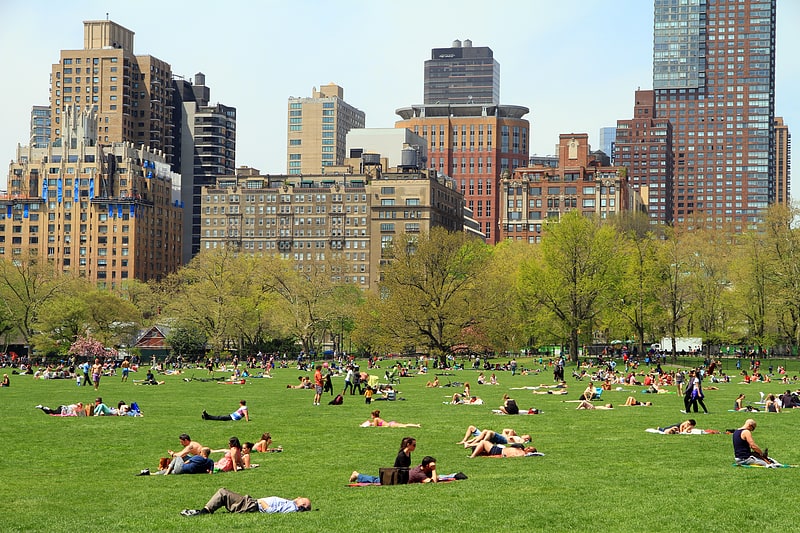
Urban oasis with ballfields and a zoo. Central Park is an urban park in New York City, between the Upper West and Upper East Sides of Manhattan. It is the fifth largest park in the city, covering 843 acres. It is the most visited urban park in the United States, with an estimated 42 million visitors annually as of 2016, and is the most filmed location in the world.
After proposals for a large park in Manhattan during the 1840s, it was approved in 1853 to cover 778 acres (315 ha). In 1857, landscape architects Frederick Law Olmsted and Calvert Vaux won a design competition for the park with their "Greensward Plan". Construction began the same year; existing structures, including a majority-Black settlement named Seneca Village, were seized through eminent domain and razed. The park's first areas were opened to the public in late 1858. Additional land at the northern end of Central Park was purchased in 1859, and the park was completed in 1876. After a period of decline in the early 20th century, New York City parks commissioner Robert Moses started a program to clean up Central Park in the 1930s. The Central Park Conservancy, created in 1980 to combat further deterioration in the late 20th century, refurbished many parts of the park starting in the 1980s.
Main attractions include landscapes such as the Ramble and Lake, Hallett Nature Sanctuary, the Jacqueline Kennedy Onassis Reservoir, and Sheep Meadow; amusement attractions such as Wollman Rink, Central Park Carousel, and the Central Park Zoo; formal spaces such as the Central Park Mall and Bethesda Terrace; and the Delacorte Theater. The biologically diverse ecosystem has several hundred species of flora and fauna. Recreational activities include carriage-horse and bicycle tours, bicycling, sports facilities, and concerts and events such as Shakespeare in the Park. Central Park is traversed by a system of roads and walkways and is served by public transportation.
Its size and cultural position make it a model for the world's urban parks. Its influence earned Central Park the designations of National Historic Landmark in 1963 and of New York City scenic landmark in 1974. Central Park is owned by the New York City Department of Parks and Recreation but has been managed by the Central Park Conservancy since 1998, under a contract with the municipal government in a public–private partnership. The Conservancy, a non-profit organization, raises Central Park's annual operating budget and is responsible for all basic care of the park.[4]
Address: 59th to 110th Street, 10022 New York City (Upper Manhattan)
Museum of Modern Art
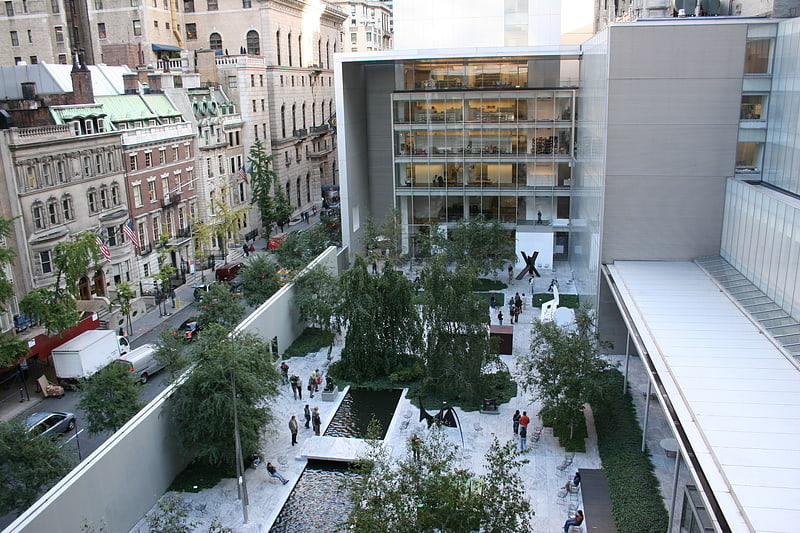
Art museum in New York City, New York. The Museum of Modern Art is an art museum located in Midtown Manhattan, New York City, on 53rd Street between Fifth and Sixth Avenues.
It plays a major role in developing and collecting modern art, and is often identified as one of the largest and most influential museums of modern art in the world. MoMA's collection offers an overview of modern and contemporary art, including works of architecture and design, drawing, painting, sculpture, photography, prints, illustrated books and artist's books, film, and electronic media.
The MoMA Library includes approximately 300,000 books and exhibition catalogs, more than 1,000 periodical titles, and more than 40,000 files of ephemera about individual artists and groups. The archives hold primary source material related to the history of modern and contemporary art.
It attracted 706,060 visitors in 2020, a drop of sixty-five percent from 2019, due to the COVID-19 pandemic. It ranked twenty-fifth on the list of most visited art museums in the world in 2020.[5]
Address: 11 W 53rd St, 10019 New York (Midtown Manhattan)
American Museum of Natural History
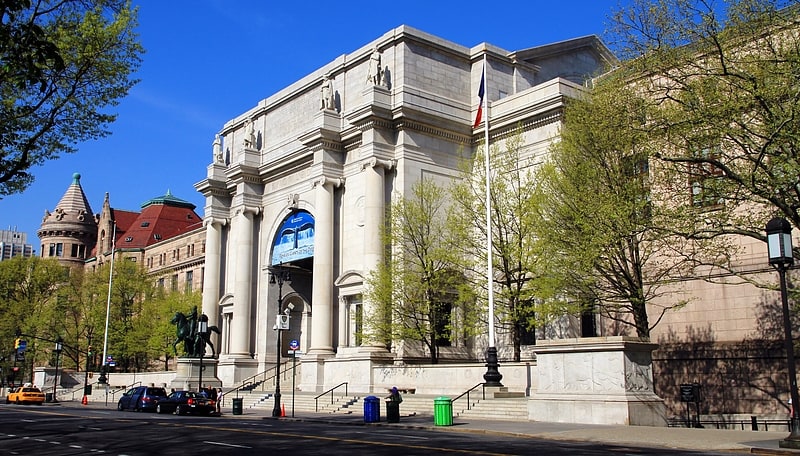
Historic museum of natural wonders. The American Museum of Natural History is a private 501 natural history museum on the Upper West Side of Manhattan in New York City. In Theodore Roosevelt Park, across the street from Central Park, the museum complex comprises 26 interconnected buildings housing 45 permanent exhibition halls, in addition to a planetarium and a library. The museum collections contain over 34 million specimens of plants, animals, fossils, minerals, rocks, meteorites, human remains, and human cultural artifacts, as well as specialized collections for frozen tissue and genomic and astrophysical data, of which only a small fraction can be displayed at any given time. The museum occupies more than 2 million square feet. AMNH has a full-time scientific staff of 225, sponsors over 120 special field expeditions each year, and averages about five million visits annually.
The mission statement of the American Museum of Natural History is: "To discover, interpret, and disseminate—through scientific research and education—knowledge about human cultures, the natural world, and the universe."[6]
Address: 79th Street, 10024 New York City (Upper Manhattan)
National September 11 Memorial & Museum
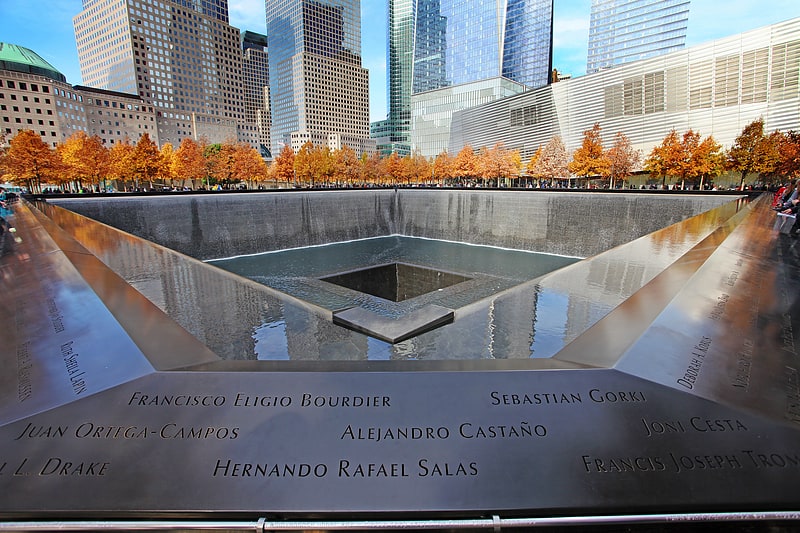
September 11 memorial and museum. The National September 11 Memorial & Museum is a memorial and museum in New York City commemorating the September 11, 2001 attacks, which killed 2,977 people, and the 1993 World Trade Center bombing, which killed six. The memorial is located at the World Trade Center site, the former location of the Twin Towers that were destroyed during the September 11 attacks. It is operated by a non-profit institution whose mission is to raise funds for, program, and operate the memorial and museum at the World Trade Center site.
A memorial was planned in the immediate aftermath of the attacks and destruction of the World Trade Center for the victims and those involved in rescue and recovery operations. The winner of the World Trade Center Site Memorial Competition was Israeli-American architect Michael Arad of Handel Architects, a New York- and San Francisco-based firm. Arad worked with landscape-architecture firm Peter Walker and Partners on the design, creating a forest of swamp white oak trees with two square reflecting pools in the center marking where the Twin Towers stood. In August 2006, the World Trade Center Memorial Foundation and the Port Authority of New York and New Jersey began heavy construction on the memorial and museum. The design is consistent with the original master plan by Daniel Libeskind, which called for the memorial to be 30 feet (9.1 m) below street level—originally 70 feet (21 m)—in a plaza, and was the only finalist to disregard Libeskind's requirement that the buildings overhang the footprints of the Twin Towers. The World Trade Center Memorial Foundation was renamed the National September 11 Memorial & Museum in 2007.
A dedication ceremony commemorating the tenth anniversary of the attacks was held at the memorial on September 11, 2011, and it opened to the public the following day. The museum was dedicated on May 15, 2014, with remarks from then mayor of New York City Michael Bloomberg and then President Barack Obama. Six days later, the museum opened to the public.[7]
Address: 180 Greenwich St, 10007 New York (Downtown Manhattan)
Whitney Museum of American Art

Museum with 20th and 21st-century art. The Whitney Museum of American Art, known informally as "The Whitney", is an art museum in the Meatpacking District and West Village neighborhoods of Manhattan in New York City. It was founded in 1930 by Gertrude Vanderbilt Whitney, a wealthy and prominent American socialite and art patron after whom it is named.
The Whitney focuses on 20th- and 21st-century American art. Its permanent collection, spanning the late-19th century to the present, comprises more than 25,000 paintings, sculptures, drawings, prints, photographs, films, videos, and artifacts of new media by more than 3,500 artists. It places particular emphasis on exhibiting the work of living artists as well as maintaining an extensive permanent collection of important pieces from the first half of the last century. The museum's Annual and Biennial exhibitions have long been a venue for younger and lesser-known artists whose work is showcased there.
From 1966 to 2014, the Whitney was at 945 Madison Avenue on Manhattan's Upper East Side in a building designed by Marcel Breuer and Hamilton P. Smith. The museum closed in October 2014 to relocate to its current building, which was designed by Renzo Piano at 99 Gansevoort Street and opened on May 1, 2015.[8]
Address: 99 Gansevoort St, 10014 New York (Downtown Manhattan)
Brooklyn Bridge
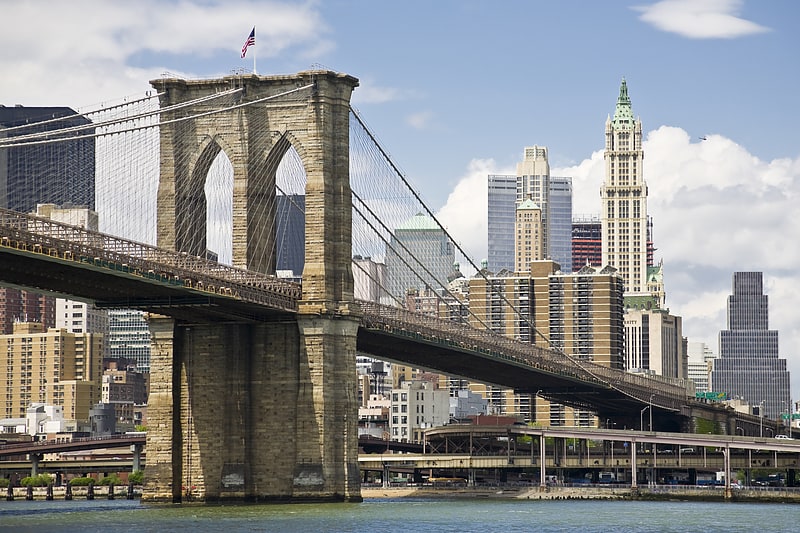
Landmark 19th-century bridge. The Brooklyn Bridge is a hybrid cable-stayed/suspension bridge in New York City, spanning the East River between the boroughs of Manhattan and Brooklyn. Opened on May 24, 1883, the Brooklyn Bridge was the first fixed crossing of the East River. It was also the longest suspension bridge in the world at the time of its opening, with a main span of 1,595.5 feet and a deck 127 ft above mean high water. The span was originally called the New York and Brooklyn Bridge or the East River Bridge but was officially renamed the Brooklyn Bridge in 1915.
Proposals for a bridge connecting Manhattan and Brooklyn were first made in the early 19th century, which eventually led to the construction of the current span, designed by John A. Roebling. The project's chief engineer, his son Washington Roebling, contributed further design work, assisted by the latter's wife, Emily Warren Roebling. Construction started in 1870, with the Tammany Hall-controlled New York Bridge Company overseeing construction, although numerous controversies and the novelty of the design prolonged the project over thirteen years. Since opening, the Brooklyn Bridge has undergone several reconfigurations, having carried horse-drawn vehicles and elevated railway lines until 1950. To alleviate increasing traffic flows, additional bridges and tunnels were built across the East River. Following gradual deterioration, the Brooklyn Bridge has been renovated several times, including in the 1950s, 1980s, and 2010s.
The Brooklyn Bridge is the southernmost of the four toll-free vehicular bridges connecting Manhattan Island and Long Island, with the Manhattan Bridge, the Williamsburg Bridge, and the Queensboro Bridge to the north. Only passenger vehicles and pedestrian and bicycle traffic are permitted. A major tourist attraction since its opening, the Brooklyn Bridge has become an icon of New York City. Over the years, the bridge has been used as the location of various stunts and performances, as well as several crimes and attacks. The Brooklyn Bridge has been designated a National Historic Landmark, a New York City landmark, and a National Historic Civil Engineering Landmark.[9]
Address: Brooklyn Bridge, New York City
The Cloisters
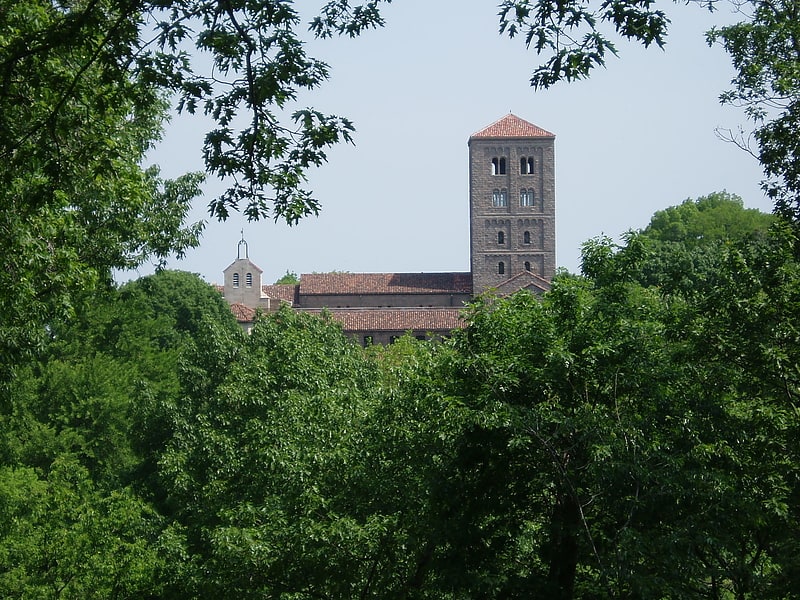
Medieval art in a rebuilt monastery. The Cloisters, also known as the Met Cloisters, is a museum in Fort Tryon Park in Washington Heights, Manhattan, New York City, specializing in European medieval art and architecture, with a focus on the Romanesque and Gothic periods. Governed by the Metropolitan Museum of Art, it contains a large collection of medieval artworks shown in the architectural settings of French monasteries and abbeys. Its buildings are centered around four cloisters—the Cuxa, Saint-Guilhem, Bonnefont and Trie—that were acquired by American sculptor and art dealer George Grey Barnard in France before 1913, and moved to New York. Barnard's collection was bought for the museum by financier and philanthropist John D. Rockefeller, Jr. Other major sources of objects were the collections of J. P. Morgan and Joseph Brummer.
The museum's building was designed by the architect Charles Collens, on a site on a steep hill, with upper and lower levels. It contains medieval gardens and a series of chapels and themed galleries, including the Romanesque, Fuentidueña, Unicorn, Spanish and Gothic rooms. The design, layout, and ambiance of the building are intended to evoke a sense of medieval European monastic life. It holds about 5,000 works of art and architecture, all European and mostly dating from the Byzantine to the early Renaissance periods, mainly during the 12th through 15th centuries. The varied objects include stone and wood sculptures, tapestries, illuminated manuscripts and panel paintings, of which the best known include the c. 1422 Early Netherlandish Mérode Altarpiece and the c. 1495–1505 Flemish Hunt of the Unicorn tapestries.
Rockefeller purchased the museum site in Washington Heights in 1930, and donated it and the Bayard collection to the Metropolitan in 1931. Upon its opening on May 10, 1938, the Cloisters was described as a collection "shown informally in a picturesque setting, which stimulates imagination and creates a receptive mood for enjoyment".[10]
Address: 99 Margaret Corbin Dr, 10040 New York (Upper Manhattan)
Empire State Building
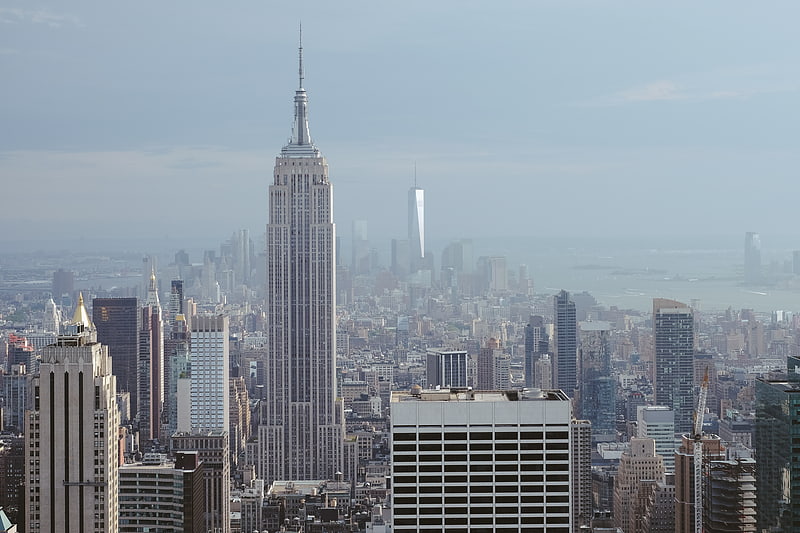
Skyscraper in New York City, New York. The Empire State Building is a 102-story Art Deco skyscraper in Midtown Manhattan in New York City, United States. It was designed by Shreve, Lamb & Harmon and built from 1930 to 1931. Its name is derived from "Empire State", the nickname of the state of New York. The building has a roof height of 1,250 feet and stands a total of 1,454 feet tall, including its antenna. The Empire State Building stood as the world's tallest building until the construction of the World Trade Center in 1970; following the latter's collapse in 2001, the Empire State Building was again the city's tallest skyscraper until 2012. As of 2020, the building is the seventh-tallest building in New York City, the ninth-tallest completed skyscraper in the United States, the 49th-tallest in the world, and the sixth-tallest freestanding structure in the Americas.
The site of the Empire State Building, in Midtown South on the west side of Fifth Avenue between West 33rd and 34th Streets, was developed in 1893 as the Waldorf–Astoria Hotel. In 1929, Empire State Inc. acquired the site and devised plans for a skyscraper there. The design for the Empire State Building was changed fifteen times until it was ensured to be the world's tallest building. Construction started on March 17, 1930, and the building opened thirteen and a half months afterward on May 1, 1931. Despite favorable publicity related to the building's construction, because of the Great Depression and World War II, its owners did not make a profit until the early 1950s.
The building's Art Deco architecture, height, and observation decks have made it a popular attraction. Around four million tourists from around the world annually visit the building's 86th- and 102nd-floor observatories; an additional indoor observatory on the 80th floor opened in 2019. The Empire State Building is an American cultural icon: it has been featured in more than 250 TV shows and movies since the film King Kong was released in 1933. The building's size has become the global standard of reference to describe the height and length of other structures. A symbol of New York City, the building has been named as one of the Seven Wonders of the Modern World by the American Society of Civil Engineers. It was ranked first on the American Institute of Architects' List of America's Favorite Architecture in 2007. Additionally, the Empire State Building and its ground-floor interior were designated city landmarks by the New York City Landmarks Preservation Commission in 1980, and were added to the National Register of Historic Places as a National Historic Landmark in 1986.[11]
Address: 345 5th Ave, 10016 New York (Midtown Manhattan)
Brooklyn Museum

Premier arts attraction on Prospect Park. The Brooklyn Museum is an art museum located in the New York City borough of Brooklyn. At 560,000 square feet, the museum is New York City's third largest in physical size and holds an art collection with roughly 500,000 objects.
Located near the Prospect Heights, Crown Heights, Flatbush, and Park Slope neighborhoods of Brooklyn and founded in 1895, the Beaux-Arts building, designed by McKim, Mead and White, was planned to be the largest art museum in the world. The museum initially struggled to maintain its building and collection, only to be revitalized in the late 20th century, thanks to major renovations. Significant areas of the collection include antiquities, specifically their collection of Egyptian antiquities spanning over 3,000 years. European, African, Oceanic, and Japanese art make for notable antiquities collections as well. American art is heavily represented, starting at the Colonial period. Artists represented in the collection include Mark Rothko, Edward Hopper, Norman Rockwell, Winslow Homer, Edgar Degas, Georgia O'Keeffe, and Max Weber. The museum features the Steinberg Family Sculpture Garden, which features salvaged architectural elements from throughout New York City.[12]
Address: 200 Eastern Pkwy, 11238-6052 Brooklyn (South Brooklyn)
Battery Park
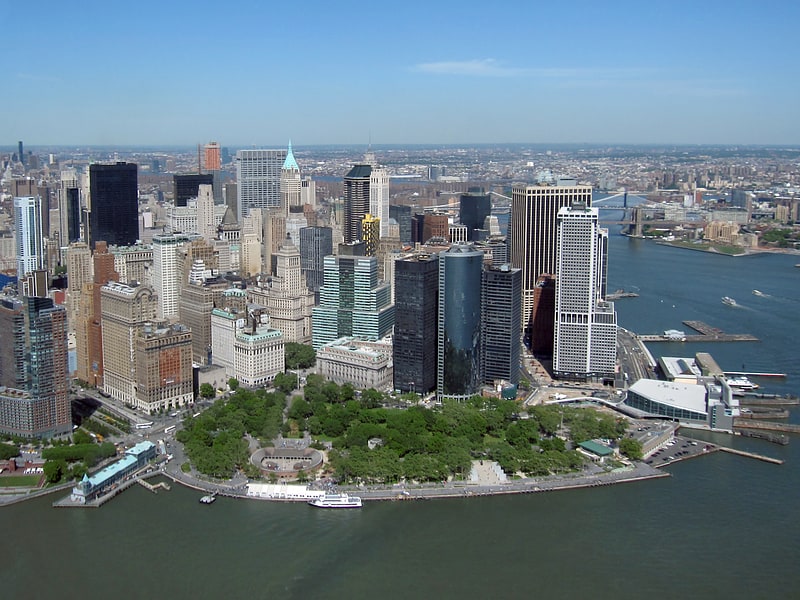
Waterfront park with harbor views. The Battery, formerly known as Battery Park, is a 25-acre public park located at the southern tip of Manhattan Island in New York City facing New York Harbor. It is bounded by Battery Place on the north, State Street on the east, New York Harbor to the south, and the Hudson River to the west. The park contains attractions such as an early 19th century fort named Castle Clinton; multiple monuments; and the SeaGlass Carousel. The surrounding area, known as South Ferry, contains multiple ferry terminals, including the Staten Island Ferry's Whitehall Terminal; a boat launch to the Statue of Liberty National Monument; and a boat launch to Governors Island.
The park and surrounding area is named for the artillery batteries that were built in the late 17th century to protect the settlement behind them. By the 1820s, the Battery had become an entertainment destination, with the conversion of Castle Clinton into a theater venue. During the mid-19th century, the modern-day Battery Park was constructed and Castle Clinton was converted into an immigration and customs center. The Battery was commonly known as the landing point for immigrants to New York City until 1890, when the Castle Clinton immigration center was replaced by one on Ellis Island. Castle Clinton then hosted the New York Aquarium from 1896 to 1941.
In 1940, the entirety of Battery Park was closed for twelve years due to the construction of the Brooklyn–Battery Tunnel and the Battery Park Underpass. The park reopened in 1952 after a renovation, but then subsequently went into decline. The Battery Conservancy, founded in 1994 by Warrie Price, underwrote and funded the restoration and improvement of the once-dilapidated park. In 2015, the Conservancy renamed the park to its historic name of "the Battery".[13]
Address: 75 Battery Pl, 10280-1500 New York City (Downtown Manhattan)
South Street Seaport
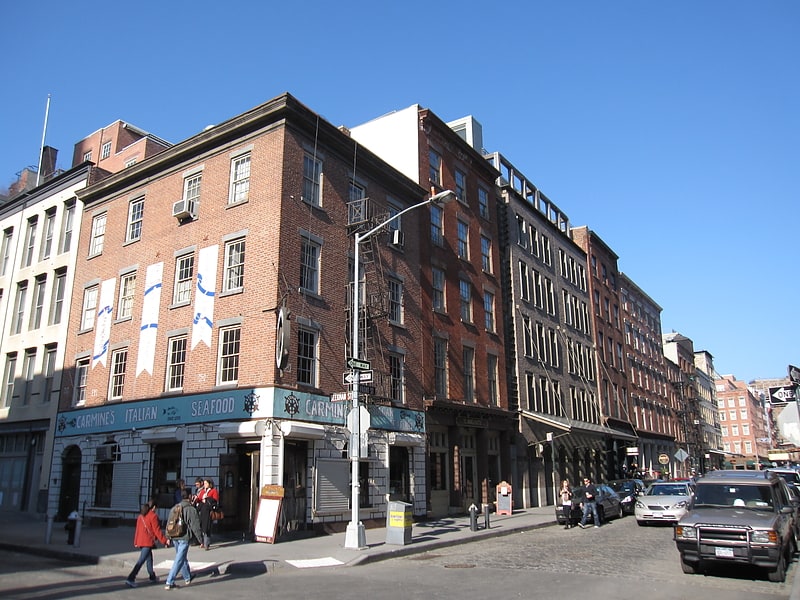
Mall. The South Street Seaport is a historic area in the New York City borough of Manhattan, centered where Fulton Street meets the East River, and adjacent to the Financial District. The Seaport is a designated historic district, and is distinct from the neighboring Financial District. It is part of Manhattan Community Board 1 in Lower Manhattan, and is bounded by the Financial District to the west, southwest, and north; the East River to the southeast; and Two Bridges to the northeast.
It features some of the oldest architecture in downtown Manhattan, and includes the largest concentration of restored early 19th-century commercial buildings in the city. This includes renovated original mercantile buildings, renovated sailing ships, the former Fulton Fish Market, and modern tourist malls featuring food, shopping, and nightlife.[14]
Address: 19 Fulton St, 10038 New York (Downtown Manhattan)
Intrepid Sea

Flight museum on an aircraft carrier. The Intrepid Sea, Air & Space Museum is an American military and maritime history museum in New York City with a collection of museum ships. It is located at Pier 86 at 46th Street, along the Hudson River, in the Hell's Kitchen neighborhood on the West Side of Manhattan. The museum showcases the aircraft carrier USS Intrepid, the cruise missile submarine USS Growler, a Concorde SST, a Lockheed A-12 supersonic reconnaissance plane, and the Space Shuttle Enterprise. On the lower deck there is also a reproduction of a World War I biplane.
Founded in 1982, the museum closed in 2006 for a 1.5-year renovation of Intrepid and facilities. Those included new exhibits. The museum reopened to the public on November 8, 2008.[15]
Address: W 46th St, 10036 New York (Midtown Manhattan)
Museum at Eldridge Street
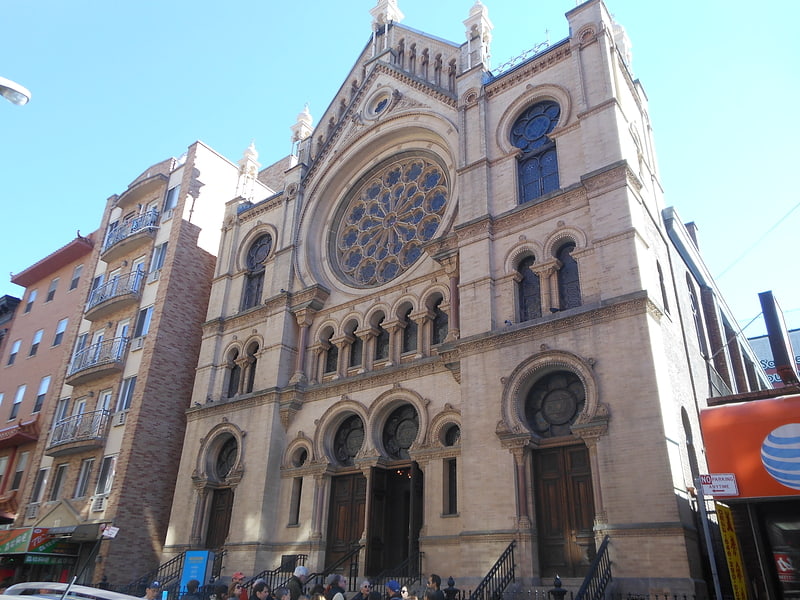
Synagogue in New York. The Eldridge Street Synagogue is a synagogue and National Historic Landmark in Chinatown, Manhattan, New York City. Built in 1887, it is one of the first synagogues erected in the United States by Eastern European Jews.
The Orthodox congregation that constructed the synagogue moved into the downstairs beth midrash in the 1950s, and the main sanctuary was unused until the 1980s, when it was restored to become the Museum at Eldridge Street.[16]
Address: 12 Eldridge St, 10002 New York (Downtown Manhattan)
High Line
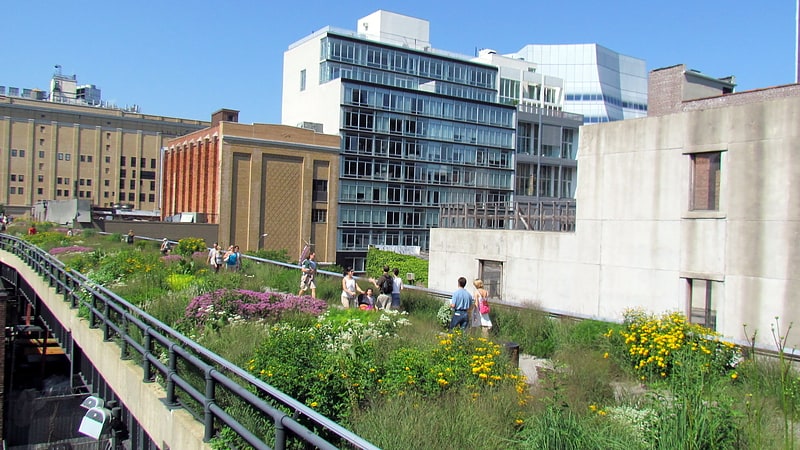
Park built into old elevated rail line. The High Line is a 1.45-mile-long elevated linear park, greenway and rail trail created on a former New York Central Railroad spur on the west side of Manhattan in New York City. The High Line's design is a collaboration between James Corner Field Operations, Diller Scofidio + Renfro, and Piet Oudolf. The abandoned spur has been redesigned as a "living system" drawing from multiple disciplines which include landscape architecture, urban design, and ecology. The High Line was inspired by the 4.7 km long Promenade plantée, a similar project in Paris completed in 1993.
The park is built on a disused, southern viaduct section of the New York Central Railroad's West Side Line. Originating in the Meatpacking District, the park runs from Gansevoort Street – three blocks below 14th Street – through Chelsea to the northern edge of the West Side Yard on 34th Street near the Javits Center. The West Side Line formerly extended south to a railroad terminal at Spring Street, just north of Canal Street, and north to 35th Street at the site of the Javits Center. Due to a decline in rail traffic along the rest of the viaduct, it was effectively abandoned in 1980 when the construction of the Javits Center required the demolition of the viaduct's northernmost portion. The southern portion of the viaduct was demolished in segments during the late 20th century. Repurposing the railway into an urban park began in 2006 and opened in phases during 2009, 2011, and 2014. The Spur, an extension of the High Line that originally connected with the Morgan General Mail Facility at Tenth Avenue and 30th Street, opened on June 4, 2019, as the final part of the park to open.
Since opening in June 2009, the High Line has become an icon of American contemporary landscape architecture. The High Line's success has inspired cities throughout the United States to redevelop obsolete infrastructure as public space. The park became a tourist attraction and spurred real estate development in adjacent neighborhoods, increasing real-estate values and prices along the route. By September 2014, the park had nearly five million visitors annually, and by 2019, it had eight million visitors per year.[17]
Prospect Park
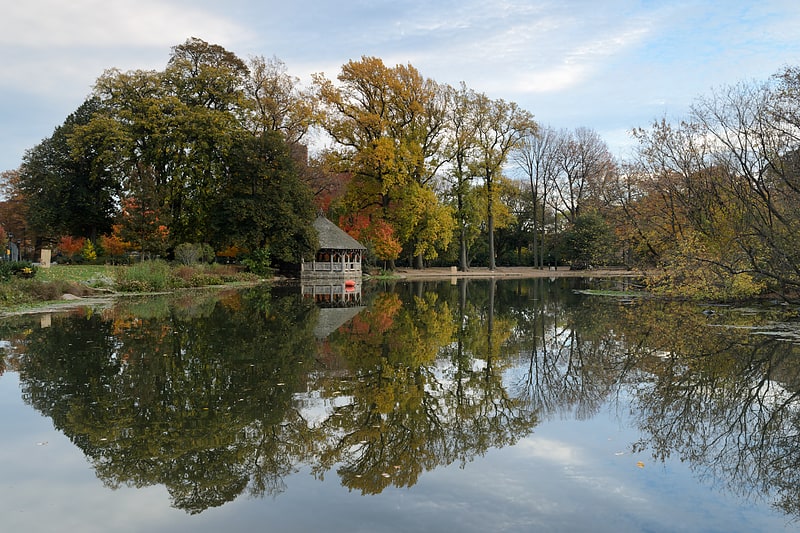
City green space with basketball courts. Prospect Park is an urban park in Brooklyn, New York City. The park is situated between the neighborhoods of Park Slope, Prospect Heights, Prospect Lefferts Gardens, Flatbush, and Windsor Terrace, and is adjacent to the Brooklyn Museum, Grand Army Plaza, and the Brooklyn Botanic Garden. With an area of 526 acres, Prospect Park is the second largest public park in Brooklyn, behind Marine Park.
First proposed in legislation passed in 1859, Prospect Park was laid out by Frederick Law Olmsted and Calvert Vaux, who also helped design Manhattan's Central Park, following various changes to its design. Prospect Park opened in 1867, though it was not substantially complete until 1873. The park subsequently underwent numerous modifications and expansions to its facilities. Several additions to the park were completed in the 1890s, in the City Beautiful architectural movement. In the early 20th century, New York City Department of Parks and Recreation (NYC Parks) commissioner Robert Moses started a program to clean up Prospect Park. A period of decline in the late 20th century spurred the creation of the Prospect Park Alliance, which refurbished many parts of the park starting in the late 1980s.
Main attractions of the park include the 90-acre (36 ha) Long Meadow; the Picnic House; Litchfield Villa; Prospect Park Zoo; the Boathouse; Concert Grove; Brooklyn's only lake, covering 60 acres (24 ha); and the Prospect Park Bandshell that hosts free outdoor concerts in the summertime. The park also has sports facilities, including the Prospect Park Tennis Center, basketball courts, baseball fields, soccer fields, and the New York Pétanque Club in the Parade Ground. There is also a private Society of Friends (Quaker) cemetery on Quaker Hill near the ball fields. In addition, Prospect Park is part of the Brooklyn-Queens Greenway, a network of green spaces that stretch across western Long Island.
Prospect Park was designated a New York City scenic landmark on November 25, 1975, and was listed on the National Register of Historic Places on September 17, 1980. The park is operated by the Prospect Park Alliance and NYC Parks.[18]
Address: Prospect Park, 11215 Brooklyn (South Brooklyn)
Bronx Zoo
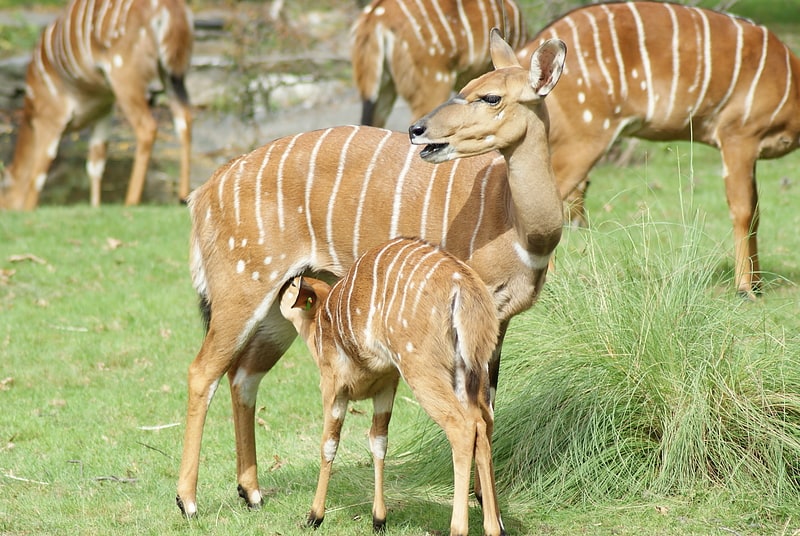
Zoo in the Bronx, New York. The Bronx Zoo is a zoo within Bronx Park in the Bronx, New York. It is one of the largest zoos in the United States by area and is the largest metropolitan zoo in the United States by area, comprising 265 acres of park lands and naturalistic habitats separated by the Bronx River. On average, the zoo has 2.15 million visitors each year as of 2009. The zoo's original permanent buildings, known as Astor Court, were designed as a series of Beaux-Arts pavilions grouped around the large circular sea lion pool. The Rainey Memorial Gates were designed by sculptor Paul Manship in 1934 and listed on the National Register of Historic Places in 1972.
The zoo opened on November 8, 1899, featuring 843 animals in 22 exhibits. Its first director was William Temple Hornaday, who served as director for 30 years. From its inception the zoo has played a vital role in animal conservation. In 1905, the American Bison Society was created in an attempt to save the American bison from extinction, which had been depleted from tens-of-millions of animals to only a few hundred. Two years later they were successfully reintroduced into the wild. In 2007, the zoo successfully reintroduced three Chinese alligators into the wild. The breeding was a milestone in the zoo's 10-year effort to reintroduce the species to the Yangtze River in China.
Today, the Bronx Zoo is world-renowned for its large and diverse animal collection, and its award-winning exhibitions. The zoo is part of an integrated system of four zoos and one aquarium managed by the Wildlife Conservation Society (WCS), and it is accredited by the Association of Zoos and Aquariums (AZA).[19]
Address: 2300 Southern Blvd, 10460 The Bronx (West Bronx)
One World Trade Center
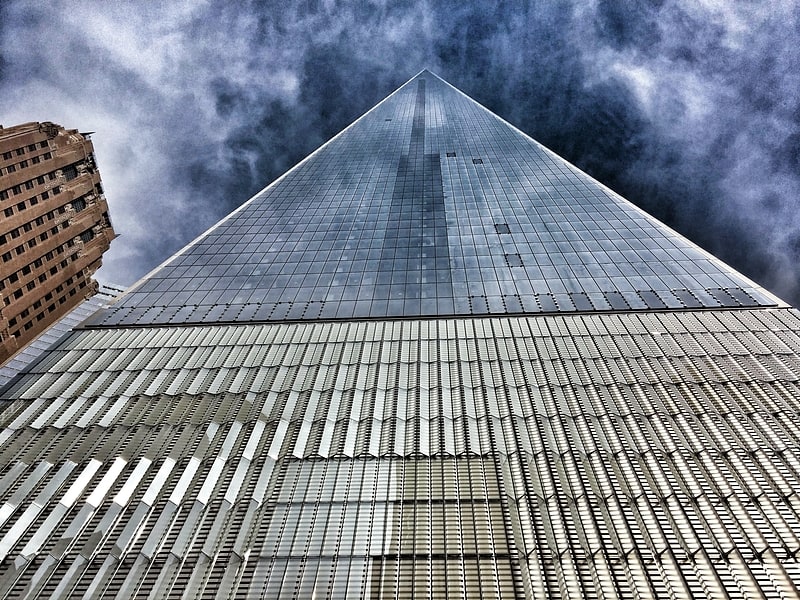
Dining and drinks on the 101st floor. One World Trade Center is the main building of the rebuilt World Trade Center complex in Lower Manhattan, New York City. One WTC is the tallest building in the United States, the tallest building in the Western Hemisphere, and the seventh-tallest in the world. The supertall structure has the same name as the North Tower of the original World Trade Center, which was destroyed in the terrorist attacks of September 11, 2001. The new skyscraper stands on the northwest corner of the 16-acre World Trade Center site, on the site of the original 6 World Trade Center. The building is bounded by West Street to the west, Vesey Street to the north, Fulton Street to the south, and Washington Street to the east.
The building's architect is David Childs, whose firm Skidmore, Owings & Merrill (SOM) also designed the Burj Khalifa and the Willis Tower. The construction of below-ground utility relocations, footings, and foundations for the new building began on April 27, 2006. One World Trade Center became the tallest structure in New York City on April 30, 2012, when it surpassed the height of the Empire State Building. The tower's steel structure was topped out on August 30, 2012. On May 10, 2013, the final component of the skyscraper's spire was installed, making the building, including its spire, reach a total height of 1,776 feet (541 m). Its height in feet is a deliberate reference to the year when the United States Declaration of Independence was signed. The building opened on November 3, 2014; the One World Observatory opened on May 29, 2015.
On March 26, 2009, the Port Authority of New York and New Jersey (PANYNJ) confirmed that the building would be officially known by its legal name of "One World Trade Center", rather than its colloquial name of "Freedom Tower". The building has 94 stories, with the top floor numbered 104.
The new World Trade Center complex will eventually include five high-rise office buildings built along Greenwich Street, as well as the National September 11 Memorial & Museum, located just south of One World Trade Center where the original Twin Towers stood. The construction of the new building is part of an effort to memorialize and rebuild following the destruction of the original World Trade Center complex.[20]
Address: 285 Fulton St, 10006 New York (Downtown Manhattan)
Graduate Center
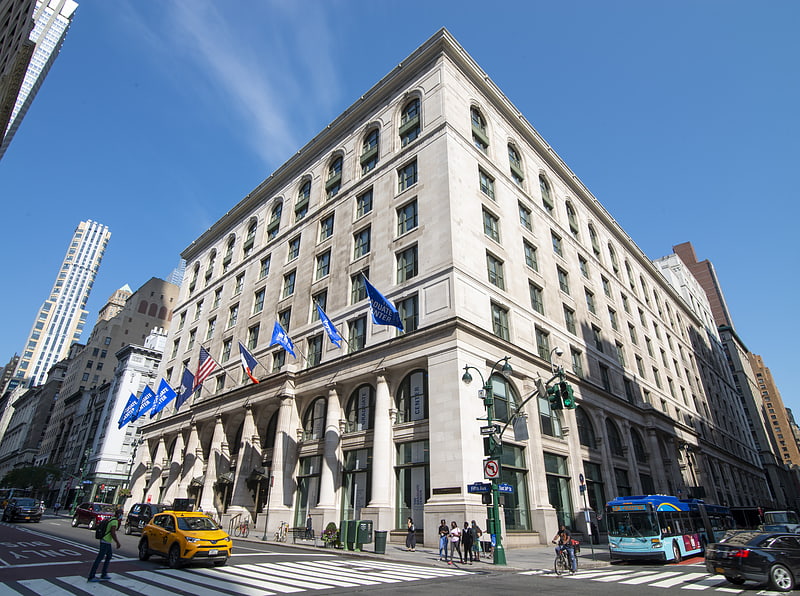
The Graduate School and University Center of the City University of New York is a public research institution and post-graduate university in New York City. Serving as the principal doctorate-granting institution of the City University of New York system, The Graduate Center is classified among "R1: Doctoral Universities – Very High Research Activity". The school is situated in the landmark B. Altman and Company Building at 365 Fifth Avenue in Midtown Manhattan, opposite the Empire State Building. The Graduate Center has 4,600 students, 31 doctoral programs, 14 master's programs, and 30 research centers and institutes. A core faculty of approximately 140 is supplemented by over 1,800 additional faculty members drawn from throughout CUNY's eleven senior colleges and New York City's cultural and scientific institutions.
The Graduate Center faculty include recipients of the Nobel Prize, the Abel Prize, Pulitzer Prize, the National Humanities Medal, the National Medal of Science, the National Endowment for the Humanities, the Rockefeller Fellowship, the Schock Prize, the Bancroft Prize, the Wolf Prize, Grammy Awards, the George Jean Nathan Award for Dramatic Criticism, Guggenheim Fellowships, the New York City Mayor's Award for Excellence in Science and Technology, the Presidential Early Career Awards for Scientists and Engineers, and memberships in the American Academy of Arts and Sciences and the National Academy of Sciences.
Several doctoral programs at the Graduate Center, including Criminal Justice, English, History, Philosophy, and Sociology, have been consistently ranked among the top 30 in the United States. For the Fall 2021 semester, 11% of applicants across all doctoral programs at the Graduate Center were offered admission.
In addition to academics, the Graduate Center extends its intellectual and cultural resources to the general public, offering access to a wide range of events, including lectures, symposia, performances, and workshops.[21]
Address: 365 5th Avenue, New York City (Midtown Manhattan)
Flatiron Building
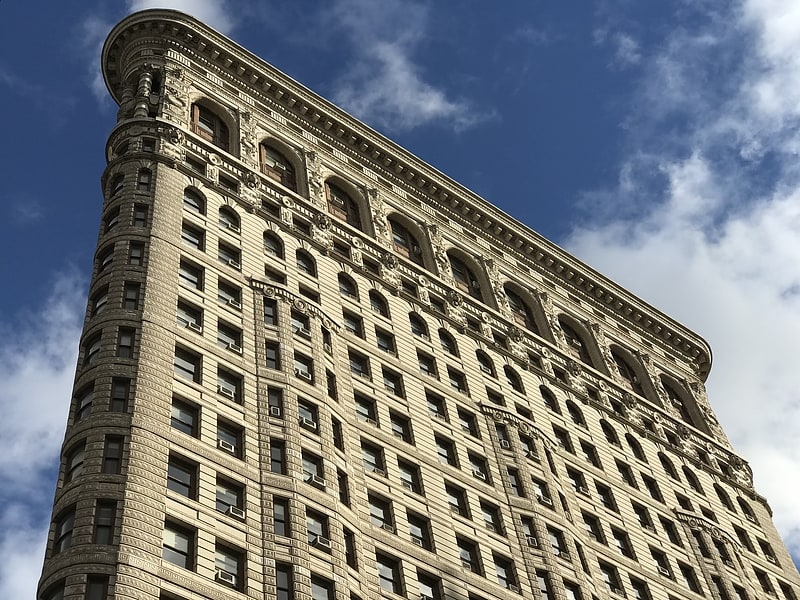
Landmark triangular 22-story building. The Flatiron Building, originally the Fuller Building, is a triangular 22-story, 285-foot-tall steel-framed landmarked building located at 175 Fifth Avenue in the eponymous Flatiron District neighborhood of the borough of Manhattan, New York City. Designed by Daniel Burnham and Frederick Dinkelberg, it was one of the tallest buildings in the city upon its 1902 completion, at 20 floors high, and one of only two "skyscrapers" north of 14th Street – the other being the Metropolitan Life Insurance Company Tower, one block east. The building sits on a triangular block formed by Fifth Avenue, Broadway, and East 22nd Street – where the building's 87-foot back end is located – with East 23rd Street grazing the triangle's northern peak. As with numerous other wedge-shaped buildings, the name "Flatiron" derives from its resemblance to a cast-iron clothes iron.
The building, which has been called "one of the world's most iconic skyscrapers and a quintessential symbol of New York City", anchors the south (downtown) end of Madison Square and the north (uptown) end of the Ladies' Mile Historic District. The neighborhood around it is called the Flatiron District after its signature, iconic building. The Flatiron Building was designated a New York City landmark in 1966, was added to the National Register of Historic Places in 1979, and was designated a National Historic Landmark in 1989.[22]
Address: 949-999 Broadway, 10010 New York (Midtown Manhattan)
Radio City Music Hall
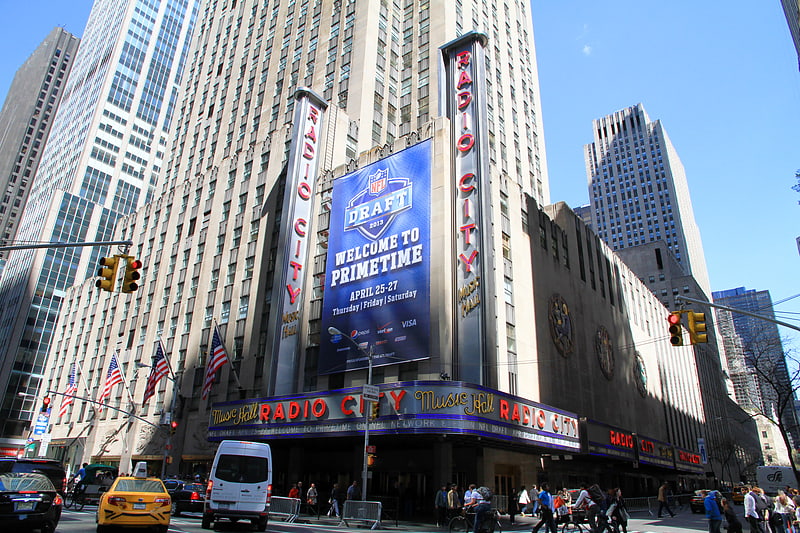
Legendary theater, home of the Rockettes. Radio City Music Hall is an entertainment venue and theater at 1260 Avenue of the Americas, within Rockefeller Center, in the Midtown Manhattan neighborhood of New York City. Nicknamed "the Showplace of the Nation", it is the headquarters for the Rockettes, the precision dance company. Radio City Music Hall was designed by Edward Durell Stone and Donald Deskey in the Art Deco style.
Radio City Music Hall was built on a plot of land that was originally intended for a Metropolitan Opera House, although plans for the opera house were canceled in 1929. It opened on December 27, 1932, as part of the construction of Rockefeller Center. The 5,960-seat Music Hall was the larger of two venues built for Rockefeller Center's "Radio City" section, the other being Center Theatre; the "Radio City" name later came to apply only to the Music Hall. It was largely successful until the 1970s, when declining patronage nearly drove the Music Hall to bankruptcy. Radio City Music Hall was designated a New York City Landmark in May 1978, and it was restored and allowed to remain open. The theater was extensively renovated in 1999.
Radio City's four-tiered auditorium was the world's largest when it opened. The theater also contains a variety of art. Although Radio City Music Hall was initially intended to host stage shows, within a year of its opening it was converted into a movie palace, hosting performances in a film-and-stage-spectacle format through the 1970s, and was the site of several movie premieres. It now primarily hosts concerts, including by leading pop and rock musicians, and live stage shows such as the Radio City Christmas Spectacular. The Music Hall has also hosted televised events including the Grammy Awards, the Tony Awards, the Daytime Emmy Awards, the MTV Video Music Awards, and the NFL Draft.[23]
Address: 1260 6th Ave, 10020 New York (Midtown Manhattan)
Brookfield Place

Center with shopping, dining and events. Brookfield Place is a shopping center and office building complex in the New York City borough of Manhattan. It is located in the Battery Park City neighborhood, across West Street from the World Trade Center, and overlooks the Hudson River. The complex is currently owned and managed by Brookfield Properties, a subsidiary of Brookfield Asset Management.[24]
Address: 230 Vesey St, 10281 New York (Downtown Manhattan)
Socrates Sculpture Park
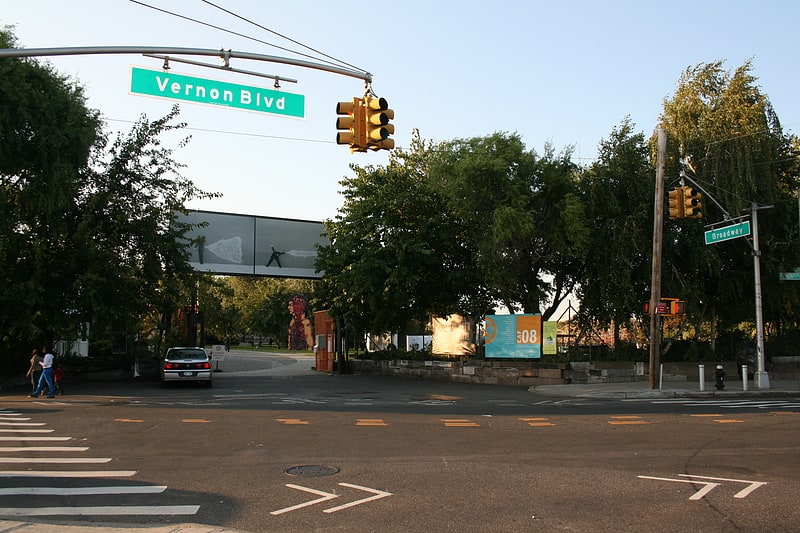
Socrates Sculpture Park is an outdoor museum and public park where artists can create and exhibit sculptures and multi-media installations. It is located one block from the Noguchi Museum at the intersection of Broadway and Vernon Boulevard in the neighborhood of Astoria, Queens, New York City. In addition to exhibition space, the park offers an arts education program, artist residency program, and job training.[25]
Address: 32-01 Vernon Blvd, 11106 Long Island City (Northwestern Queens)
One Times Square
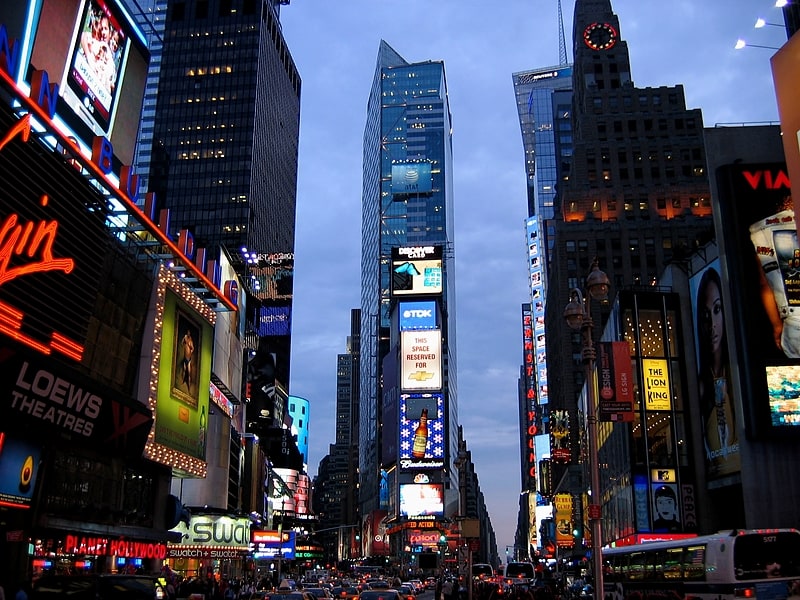
Skyscraper in New York City, New York. One Times Square, also known as 1475 Broadway, the New York Times Building, the New York Times Tower, or simply as the Times Tower, is a 25-story, 363-foot-high skyscraper, designed by Cyrus L. W. Eidlitz, located at 42nd Street and Broadway in New York City. Due to the large amount of revenue generated by its signage, One Times Square is considered one of the most valuable advertising locations in the world.
The tower was originally built in 1903–1904 to serve as the headquarters of The New York Times, which moved into the tower in January 1904. The paper's owner persuaded the city to re-name the area "Times Square". Eight years later, the paper's offices moved to 229 West 43rd Street. One Times Square remained a major focal point of the area due to its annual New Year's Eve "ball drop" festivities and the introduction of a large lighted news ticker near street-level in 1928. Following its sale to Lehman Brothers in 1995, One Times Square was repurposed with advertising billboards on its facade to take advantage of its prime location within the square. One Times Square has been owned by Jamestown L.P. since 1997.
Most of the building's interior remains vacant, aside from a Walgreens pharmacy which occupies its lower levels. In 2017, as part of One Times Square's redevelopment, plans were announced to construct a new Times Square museum, observation deck, and a new entrance to the Times Square–42nd Street subway station, construction of which began in 2019.[26]
Address: 1475 Broadway, New York City (Midtown Manhattan)
The Pool
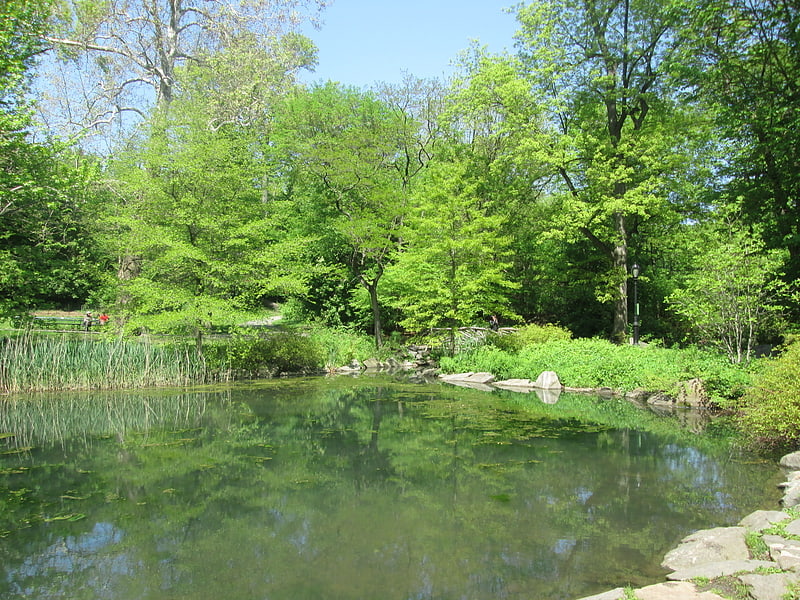
North Woods and North Meadow are two interconnected features in the northern section of Central Park, New York City, close to the neighborhoods of the Upper West Side and Harlem in Manhattan. The 90-acre North Woods, in the northwestern corner of the park, is a rugged woodland that contains a forest called the Ravine, as well as two water features called the Loch and the Pool. The western portion of the North Woods also includes Great Hill, the third highest point in Central Park. North Meadow, a recreation center and sports complex, is immediately southeast of the North Woods. Completed in the 1860s, North Woods and North Meadow were among the last parts of Central Park to be built.[27]
Address: west side of the park, New York City (Upper Manhattan)
Castle Clinton
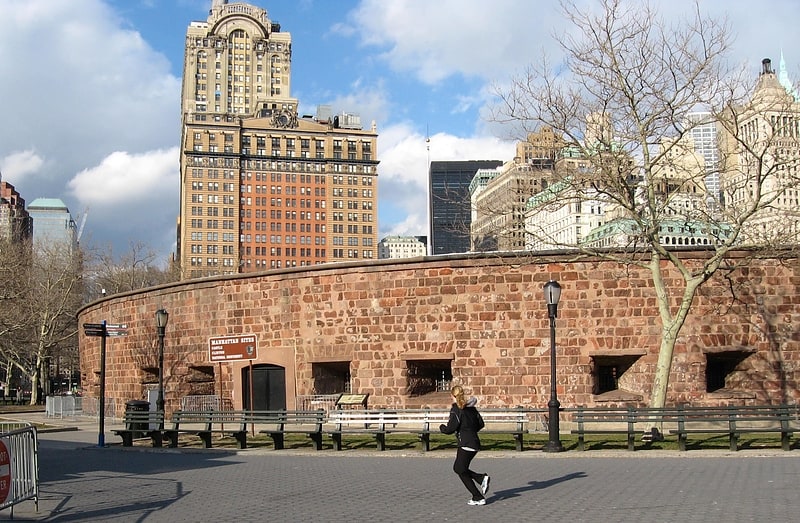
Historic fort with small museum. Castle Clinton or Fort Clinton, previously known as Castle Garden, is a circular sandstone fort located in Battery Park, in Manhattan, New York City. Built from 1808 to 1811, it was the first American immigration station, where more than 8 million people arrived in the United States from 1855 to 1890. Over its active life, it has also functioned as a beer garden, exhibition hall, theater, and public aquarium. Castle Clinton National Monument, designated in 1946, was listed on the National Register of Historic Places on October 15, 1966.[28]
Address: 26 Wall St, 10005-1996 New York City (Downtown Manhattan)
1 Wall Street
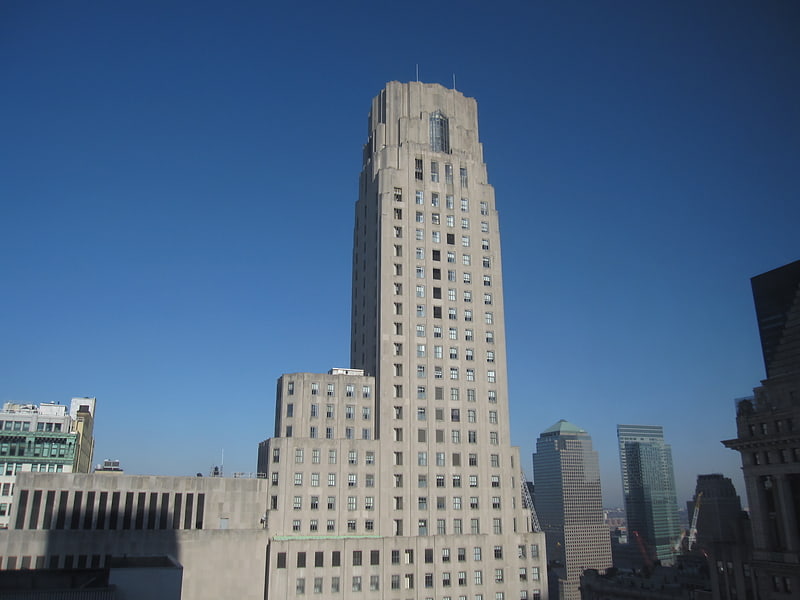
Skyscraper in New York City, New York. 1 Wall Street is a skyscraper in the Financial District of Lower Manhattan, New York City, on the eastern side of Broadway between Wall Street and Exchange Place. 1 Wall Street, designed in the Art Deco style, is 654 feet tall and consists of two sections. The original 50-story building was designed by Ralph Thomas Walker of the firm Voorhees, Gmelin and Walker and constructed between 1929 and 1931, while a 36-story annex to the south was designed by successor firm Voorhees, Walker Smith Smith & Haines and built from 1963 to 1965.
The facade, made of limestone, contains slight inwardly-curved bays with fluting to resemble curtains. On the lower stories are narrow windows with mullions, as well as ornate entrances. The massing of 1 Wall Street incorporates numerous small setbacks, and the top of the original building consists of a freestanding tower. The corners of the original building consist of chamfers, while the top of the tower has fluted windowless bays. The facade of the annex is designed in a style evocative of the original structure. Inside is an ornate main lobby with colored mosaics.
1 Wall Street had been constructed for Irving Trust, one of the larger banks in New York City in the early 20th century. At the time of its construction, the building occupied what was then considered one of the most valuable plots in the city. The building replaced three previous structures, including the Manhattan Life Insurance Building, once the world's tallest building. After Irving Trust was acquired by The Bank of New York Mellon (BNY Mellon) in 1988, 1 Wall Street subsequently served as BNY Mellon's global headquarters through 2015. After the building was purchased by Harry Macklowe, it has been undergoing a renovation since 2018, which is converting the interior to residential use with some commercial space.
The building is regarded as one of New York City's Art Deco landmarks, despite initially remaining ignored in favor of such buildings as the Empire State Building and the Chrysler Building. The New York City Landmarks Preservation Commission designated the original portion of the building as a city landmark in 2001. It is also a contributing property to the Wall Street Historic District, a National Register of Historic Places district created in 2007.[29]
Address: 1 Wall Street, New York City (Downtown Manhattan)
Chrysler Building
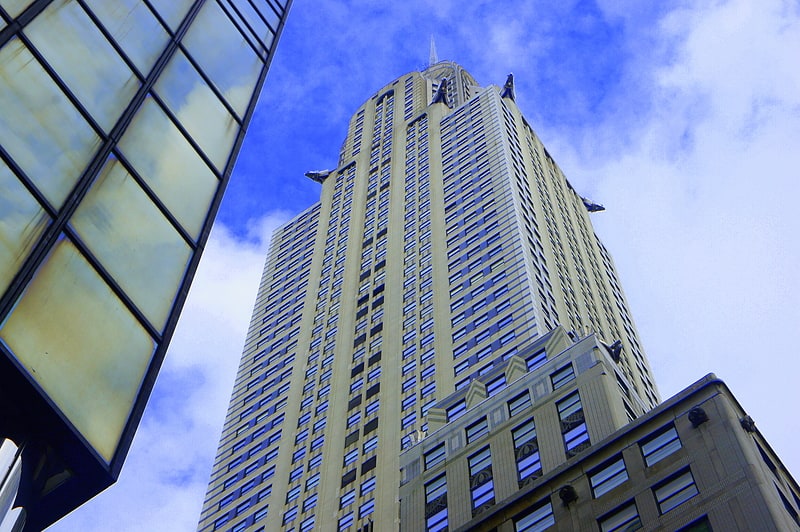
1930s art deco tower with a storied past. The Chrysler Building is an Art Deco skyscraper in the Turtle Bay neighborhood on the East Side of Manhattan, New York City, at the intersection of 42nd Street and Lexington Avenue in Midtown Manhattan. At 1,046 feet, it is the tallest brick building in the world with a steel framework, and was the world's tallest building for 11 months after its completion in 1930. As of 2019, the Chrysler is the 11th-tallest building in the city, tied with The New York Times Building.
Originally a project of real estate developer and former New York State Senator William H. Reynolds, the building was constructed by Walter Chrysler, the head of the Chrysler Corporation. The construction of the Chrysler Building, an early skyscraper, was characterized by a competition with 40 Wall Street and the Empire State Building to become the world's tallest building. Although the Chrysler Building was built and designed specifically for the car manufacturer, the corporation did not pay for its construction and never owned it; Walter Chrysler decided to fund the entire cost personally so his children could inherit it. An annex was completed in 1952, and the building was sold by the Chrysler family the next year, with numerous subsequent owners.
When the Chrysler Building opened, there were mixed reviews of the building's design, ranging from views of it as inane and unoriginal to the idea that it was modernist and iconic. Perceptions of the building have slowly evolved into its now being seen as a paragon of the Art Deco architectural style; and in 2007, it was ranked ninth on the List of America's Favorite Architecture by the American Institute of Architects. The building was designated a New York City landmark in 1978, and was added to the National Register of Historic Places as a National Historic Landmark in 1976.[30]
Address: 405 Lexington and 42nd St., 10174 New York City (Midtown Manhattan)
Cathedral of Saint John the Divine
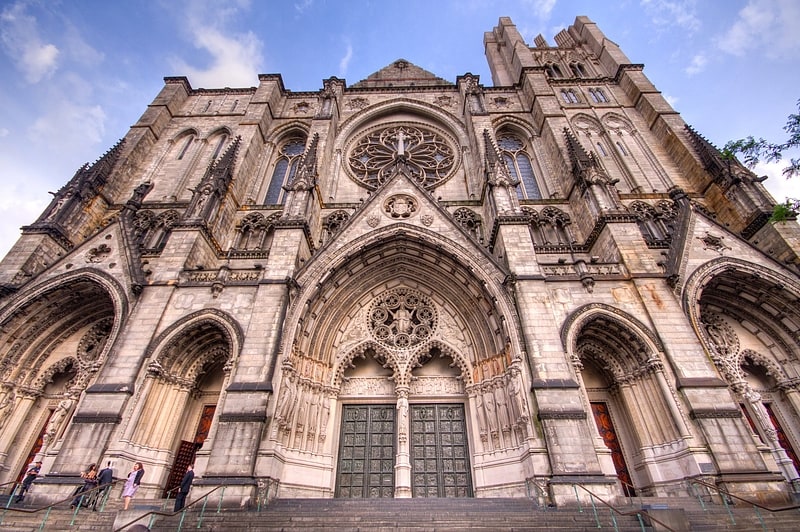
Cathedral in New York City, New York. The Cathedral of St. John the Divine is the cathedral of the Episcopal Diocese of New York. It is at 1047 Amsterdam Avenue in the Morningside Heights neighborhood of Manhattan in New York City, between West 110th Street and West 113th Street.
The cathedral is an unfinished building, with only two-thirds of the proposed building completed, due to several major stylistic changes and work interruptions. The original design, in the Byzantine Revival and Romanesque Revival styles, began construction in 1892. After the opening of the crossing in 1909, the overall plan was changed to a Gothic Revival design. The completion of the nave was delayed until 1941 due to various funding shortfalls, and little progress has occurred since then, except for an addition to the tower at the nave's southwest corner. After a large fire damaged part of the cathedral in 2001, it was renovated and rededicated in 2008. The towers above the western facade, as well as the southern transept and a proposed steeple above the crossing, have not been completed.
Despite being incomplete, the Cathedral of St. John the Divine is the world's sixth-largest church by area and either the largest or second-largest Anglican cathedral. The floor area of St. John's is 121,000 sq ft (11,200 m2), spanning a length of 601 feet (183 m), while the roof height of the nave is 177 feet (54 m). Since the cathedral's interior is so large, it has been used for hundreds of events and art exhibitions. In addition, the Cathedral of St. John the Divine has been involved in various advocacy initiatives throughout its history.
The cathedral close includes numerous buildings: the Leake & Watts Orphan Asylum Building, the cathedral proper, the St. Faith's House, the Choir School, the Deanery, and the Bishop's House. The buildings are designed in several different styles and were built over prolonged periods of construction, with the Leake & Watts Orphan Asylum predating the cathedral itself. The cathedral close was collectively designated an official city landmark by the New York City Landmarks Preservation Commission in 2017.[31]
Address: 1047 Amsterdam Ave, 10025-1798 New York (Upper Manhattan)
V-J Day in Times Square

V-J Day in Times Square is a photograph by Alfred Eisenstaedt that portrays a U.S. Navy sailor embracing and kissing a total stranger—a dental assistant—on Victory over Japan Day in New York City's Times Square on August 14, 1945. The photograph was published a week later in Life magazine, among many photographs of celebrations around the United States that were presented in a 12-page section entitled "Victory Celebrations". A two-page spread faces a montage of three similar photographs of celebrators in Washington, D.C., Kansas City, and Miami, opposite the Eisenstaedt photograph that was given a full-page display on the right hand side.
Eisenstaedt was photographing a spontaneous event that occurred in Times Square during keen public anticipation of the announcement of the end of the war with Japan. Eisenstaedt said that he did not have an opportunity to get the names and details, because he was photographing rapidly changing events during the celebrations. The photograph does not clearly show the face of either person involved, and numerous people have claimed to be the subjects. The photograph was shot just south of 45th Street looking north from a location where Broadway and Seventh Avenue converge. Donald W. Olson and his investigative team estimate that the photograph was taken at 5:51 p.m. ET. In their history pages, Life has noted that the Eisenstaedt photograph was taken with a Leica IIIa camera.[32]
Central Park Zoo
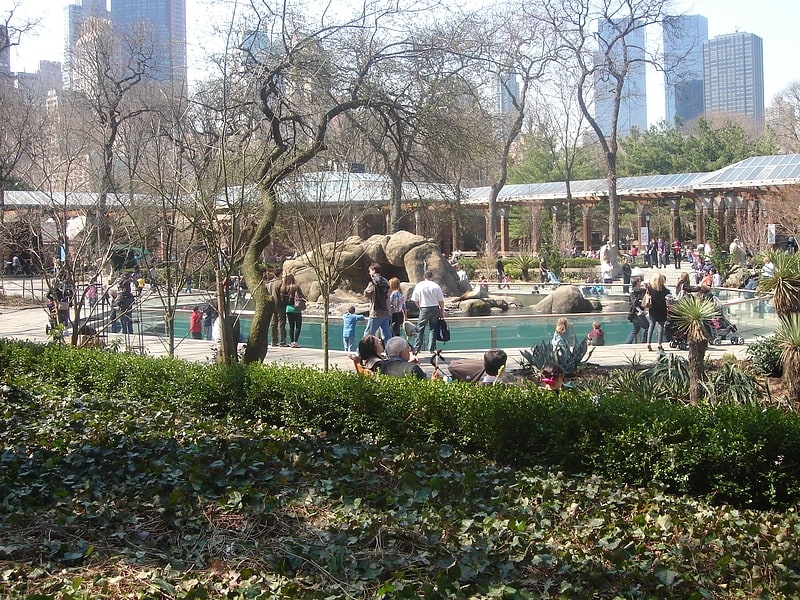
Small zoo with penguins and sea lions. The Central Park Zoo is a 6.5-acre zoo located at the southeast corner of Central Park in New York City. It is part of an integrated system of four zoos and one aquarium managed by the Wildlife Conservation Society. In conjunction with the Central Park Zoo's operations, the WCS offers children's educational programs, is engaged in restoration of endangered species populations, and reaches out to the local community through volunteer programs.
Its precursor, a menagerie, was founded in 1864, becoming the first public zoo to open in New York. The present facility first opened as a city zoo on December 2, 1934, and was part of a larger revitalization program of city parks, playgrounds and zoos initiated in 1934 by New York City Department of Parks and Recreation (NYC Parks) commissioner Robert Moses. It was built, in large part, through Civil Works Administration and Works Progress Administration (WPA) labor and funding. The Children's Zoo opened to the north of the main zoo in 1960, using funding from a donation by Senator Herbert Lehman and his wife Edith.
After 49 years of operation as a city zoo run by NYC Parks, Central Park Zoo closed in 1983 for reconstruction. The closure was part of a five-year, $35 million renovation program, that completely replaced the zoo's cages with naturalistic environments. It was rededicated on August 8, 1988, as part of a system of five facilities managed by the WCS, all of which are accredited by the Association of Zoos and Aquariums (AZA).[33]
Address: East 64th Street, 10021 New York (Upper Manhattan)
Bethesda Terrace and Fountain
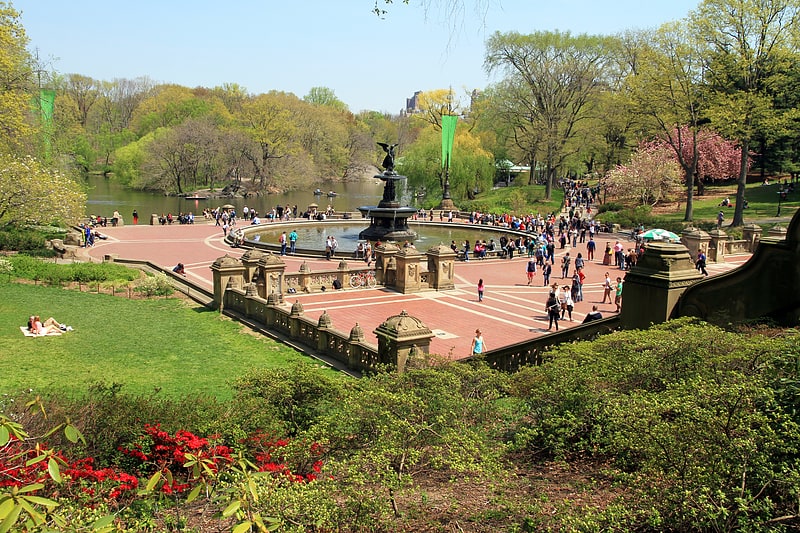
Lakeside terrace with a sizable fountain. Bethesda Terrace and Fountain are two architectural features overlooking the southern shore of the Lake in New York City's Central Park. The fountain, with its Angel of the Waters statue, is located in the center of the terrace.
Bethesda Terrace's two levels are united by two grand staircases and a lesser one that passes under Terrace Drive. They provide passage southward to the Central Park Mall and Naumburg Bandshell at the center of the park. The upper terrace flanks the 72nd Street Cross Drive and the lower terrace provides a podium for viewing the Lake. The mustard-olive colored carved stone is New Brunswick sandstone, with a harder stone for cappings, with granite steps and landings, and herringbone pattern paving of Roman brick laid on edge.[34]
Address: Mid-Park at 72nd Street, 10021 New York City (Upper Manhattan)
Victorian Gardens
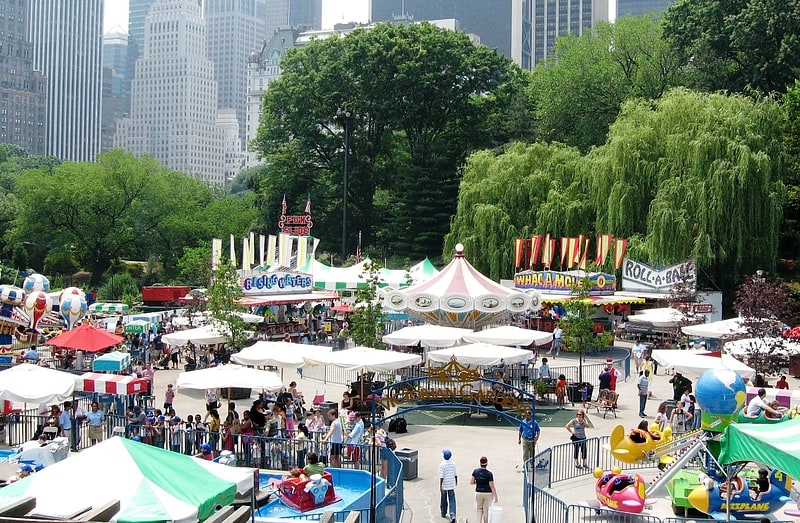
Amusement park in New York City, New York. Victorian Gardens was a seasonal traditional-style amusement park that is set up at Wollman Rink in Central Park, Manhattan, New York City, from spring through fall each year.[35]
Address: Avenue of the Americas & W 59th St, 10019 New York City (Upper Manhattan)